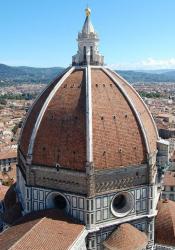Rise of Renaissance Architecture
In the early 15th century, the beginnings of the Renaissance were taking shape. One of those areas was architecture. Filippo Brunelleschi, an Italian architect, visited Rome and analyzed buildings that were built centuries ago. The rise of classicism brought back aspects of Greek and Roman architecture like symmetry and geometry and were used in projects like the interior of the Church of San Lorenzo and the Florence Cathedral. Brunelleschi is credited as the founder of Renaissance architecture and influenced future architects like Leonardo da Vinci, who used a series of squares and rectangles in his drawings, much of them included a huge dome in the center after Brunelleschi's revolutionary design.
Sources:
Ackerman, James S. “Architectural Practice in the Italian Renaissance.” Journal of the Society of Architectural Historians, vol. 13, no. 3, 1954, pp. 3–11. JSTOR, www.jstor.org/stable/987700.
Burckhardt, Jacob, et al. The Architecture of the Italian Renaissance. University of Chicago Press, 1987.
Craven, Jackie. “The Significance of Renaissance Architecture.” ThoughtCo, ThoughtCo, 6 Nov. 2019, www.thoughtco.com/renaissance-architecture-and-its-influence-178200.
Image: https://www.florenceinferno.com/the-brunelleschi-dome/

